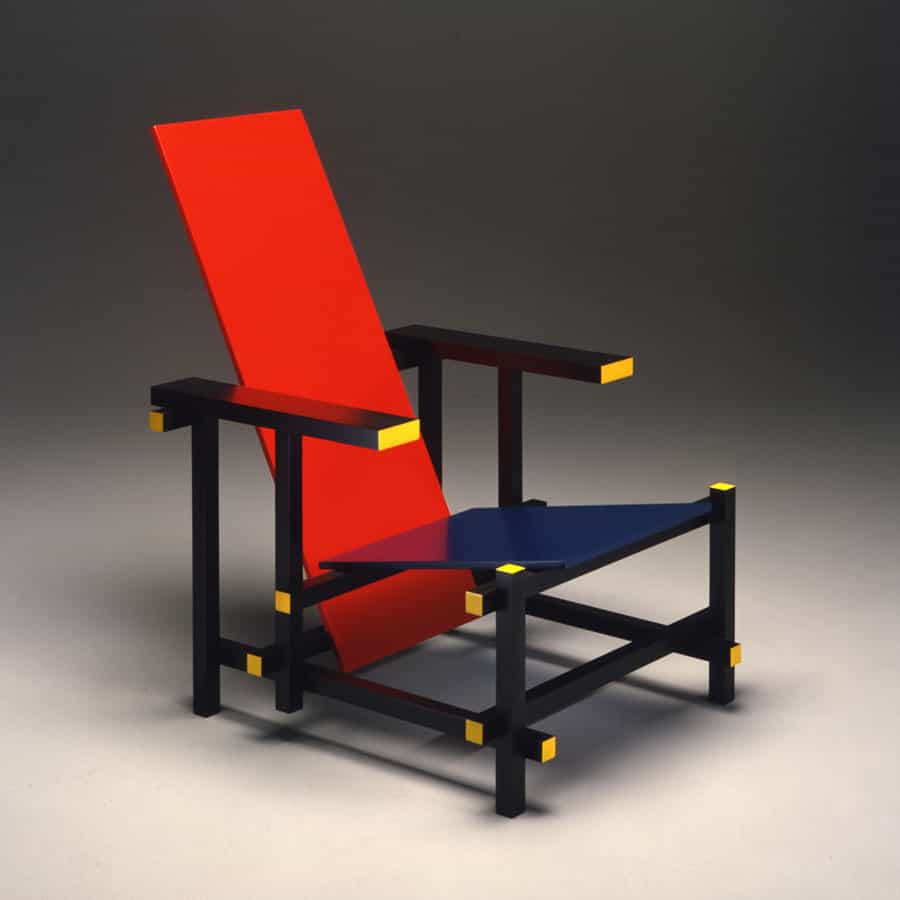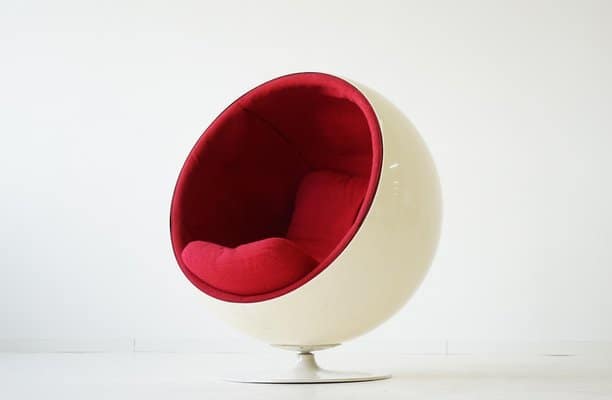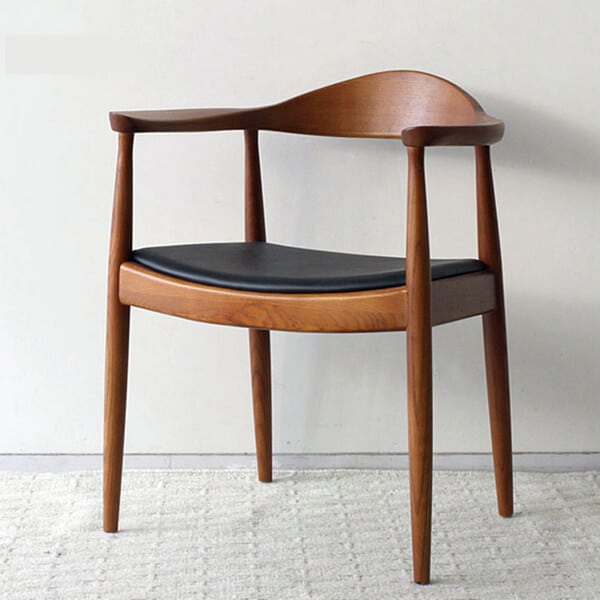Chairs have been around for almost 5000 years, with some of the first known examples being made by the ancient Egyptians. This now common, everyday object, often overlooked, has thousands if not hundreds of thousands of variations. You may wonder why chairs, merely a simple thing we sit on, are so special. Do not be fooled, not all chairs are equal. The chairs we have chosen for this list are not only unique in their design but also in the stories that they tell.

The Wassily Chair, Marcel Breuer, 1925, Source: www.vntg.com
THE WASSILY CHAIR (MODEL B3)
Marcel Breuer, 1925
Designed over the course of two years (1925-1926) by Marcel Breuer, head of the cabinet-making workshop at Bauhaus, the influential German school of modern art, this chair is definitely an icon. Despite the name, it was not specifically designed for painter Wassily Kandinsky, who worked alongside Breuer at the same time at Bauhaus. Kandinsky admired Breuer’s design of an Eisengarn (meaning iron yarn) outline with canvas seat and back, and insisted on having a duplicate made for his study. Years later when re-released by Italian manufacturer Gavina, the chair was nicknamed Wassily. Early models, before World War II, were made by German-Austrian manufacturer Thonet. After the war Gavina picked up the licensing and now, though patent designs are expired, the trademark name rights to the design are owned by Knoll of New York City.

Red and Blue Chair, Gerrit Rietveld, 1917, Source: terraingallery.org
RED AND BLUE CHAIR
Gerrit Rietveld, 1917
This chair, crafted by Dutch furniture designer Gerrit Rietveld, is one of the first explorations into a new movement which would be later named De Stijl. The chairs’ unique use of primary colours (which is a key element of De Stijl) makes it appear as if it is floating when placed upon a black background. The black wooden frame contrasts well with the colourful seating elements. In Rietveld’s instructions on how to build the chair, he informs the craftsperson to print the following verse from Der Aesthet by Christian Morgenstern underneath the seat: When I sit, I do not want / to sit like my seat-flesh likes / but rather like my seat-mind would, / if he were sitting, weave the chair for himself.

Zig Zag Chair, Gerrit Rietveld, 1934, source: www.vntg.com
ZIG ZAG CHAIR
Gerrit Rietveld, 1934
Another design created by Rietveld is the Zig Zag Chair. It consists of four wooden boards, joined together with dovetail joints in the shape of a zig zag to form a chair, hence the name. The chair was made for (and commissioned by) Dutch department store Metz & Co. who asked Rietveld to make something unprecedented – a chair for mass production. This chair was the result. As Rietveld summed it up – It is not a chair but a designer’s joke. The chair is still produced by Italian company Cassina and can be bought for around £1500.

Wiggle Side, Frank Gehry, 1972, source: 4.api.artsmia.org/800/4393.jpg
WIGGLE SIDE CHAIR
Frank Gehry, 1972
Similar to Rietveld’s Zig Zag chair, the Wiggle Side is minimalistic yet less harsh. It is a part of Gehry’s 1972 furniture series titled Easy-edges. What might be shocking to some is that this chair, as well as many other pieces in this series, were all made of cardboard, with the main goal of finding an alternative furniture material to plastic. Gehry was one of the first designers to make furniture out this material with success. He had contact with it from an early age, playing and experimenting with scrap pieces in his grandfather’s hardware store. Instead of reinforcing pieces with tabs and slots, Gehry laminated layers together increasing their strength and resilience.

Monobloc Chair, D.C. Simpson, 1946
MONOBLOC
D.C. Simpson, 1946
The monobloc is a controversial chair. Chances are you’ve seen more than one, what’s more, you’ve most likely sat in more than one. The monobloc is your typical garden chair and it can be found all around the world. It is a symbol of globalization and mass production, and that’s exactly the problem with it. But let’s start from the beginning. The monobloc was designed in 1946 by Canadian designer Douglas C. Simpson. Its name comes from the fact that it is molded from one piece of plastic (mono – one, bloc – block). Its low production cost and stackable aspect made it an easy solution for seating the masses. Its popularity though has become a problem with many, so much so that it was even banned in Basel, Switzerland for a couple of years due to destroying the cityscape. This is a prime example of how genius innovation can become a designer’s nightmare with time.

The Panton Chair, Verner Panton, 1960, source: static.vitra.com/media/asset/1749567/storage/v_fullbleed_1440x/21990672.jpg
PANTON CHAIR (STACKING CHAIR)
Verner Panton, 1960
The Panton Chair, designed by Danish designer Verner Panton, is considered to be the first moulded plastic chair. It combines ideas used by previous chairs such as a legless s-shape design similar to that of the Zig Zag. The concept of moulding plastic which was introduced with the Monobloc. All this but with its own unique twist – a representation of the Space Age style popular during the 1960s which would later become known as Pop Art. The chair is still produced by Swiss company Vitra and can be found in museums around the world such as New York’s Museum of Modern Art, London’s Design Museum, Berlin’s German Historical Museum and Copenhagen’s Danish Museum of Art & Design.

Ball Chair, Eero Aarnio, 1963, source: cdn20.pamono.com/p/g/2/3/232793_wwoxue6s4u/ball-chair-by-eero-aarnio-for-asko-1960s-1.jpg
BALL CHAIR
Eero Aarnio, 1963
The Ball Chair was crafted by Finnish designer Eero Aarnio in 1963. Created around the same time as Panton’s s-shape chair, it reflects the same Space Age style. It was made out of necessity, as Aarnio put it – We had a home but no proper big chair, so I decided to make one, but in some way a really new one. This chair has become a favorite in pop culture and it is a beloved classic of Finnish design.

The Eames Lounge Chair, Charles and Ray Eames, 1956, source: www.atakdesign.pl/
EAMES LOUNGE CHAIR
Charles and Ray Eames, 1956
The Eames Lounge Chair and ottoman, usually seen together as a set, were designed in 1956 by couple Charles and Ray Eames. This set is an icon of Modern style and a symbol of wealth. Designed with mass-production and affordability in mind it instead became a product for the high-end market. Over the years it has had slight changes and adjustments yet the overall shape has stayed the same. Examples of these furnishings are part of the permanent collection of New York’s Museum of Modern Art.

Shop Chair, Tom Sachs, 2019, source: www.shopify.com
SHOP CHAIR
Tom Sachs, 2019
For those who are familiar with the work of American contemporary Artist Tom Sachs, when you see this chair there is no mistaking it for the work of someone else. Made in the US, most models are constructed from maple plywood, featuring hand engraved detailing and sequential numbering. The ply’s of the plywood are left unpainted and exposed which coincides with Sachs’ philosophy of plywood being the queen of all building materials. The Chair can be found in many iterations (color and material) all of which retain the same shape.

The Chair, Hans J. Wegner, 1949, source: www.norpelfurniture.com/
THE CHAIR (ROUND CHAIR)
Hans J. Wegner, 1949
To top out list off, we have Hans Wegner’s piece, simply titled The Chair. Originally called Round Chair due to its round, semicircle piece which makes up the arm and back rests, it is cherished as a piece which defines Danish design. Composed of four straight legs, two arm rails, and one curved back rail, available in a variety of warm woods, it is a combination of masterful technique and organic forms. Its seat is available in either an airy woven cane or leather upholstery. Out of almost 500 chairs made by Wegner this is the one which earned the nickname The Chair. Upon its release in 1950 it was coined the most beautiful chair in the world by Interiors magazine.






